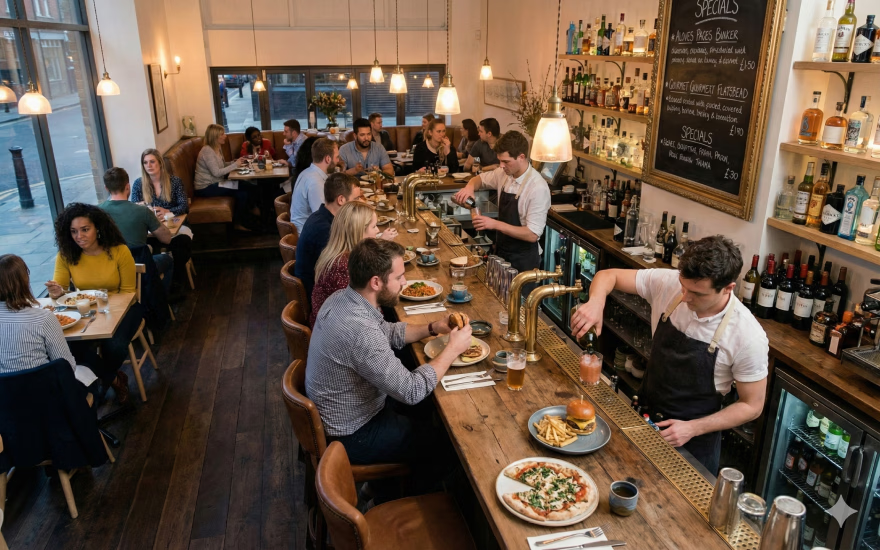How Can Toronto Restaurants Stay Competitive with Emerging Food Trends?

Toronto’s restaurant scene never stops simmering — from experimental pop-ups to culturally hyper-specific micro-concepts, the city’s dining evolution is as fast-paced as it is flavor-packed. For restaurateurs, staying competitive means recognizing that today’s trending dish may be off the menu tomorrow. But with the right strategies in place, savvy operators can do more than keep up — they can lead.
Why Are Toronto Restaurant Trends So Important Right Now?
Toronto’s culinary landscape is a pressure cooker of global influence, local innovation, labor shortages, and fluctuating diner expectations. As one of North America’s most diverse food cities, Toronto embodies what’s next in hospitality, with the restaurant market in Toronto shaped by rapid shifts in both concept and consumer behavior.
Operators must now account for:
- Rising demand for sustainable, locally sourced ingredients
- Cultural authenticity in menu design
- New competition from micro-restaurants and ghost kitchens
- Ongoing labor shortages and increased labor costs
- The influence of Gen Z and millennial diners on ambiance, tech, and menu presentation
Coupled with operational challenges, these forces are redefining what it means to succeed in Toronto’s dining scene. To future-proof a restaurant, it’s essential to understand what trends are emerging and how to convert them into long-lasting competitive advantages.
What Are the Most Notable Toronto Restaurant Trends of the Year?
The latest wave of Toronto dining innovation is all about identity, intimacy, and immersion. According to Streets of Toronto, several major trends are defining the city’s food culture in 2025:
- Upscale casual dining: Comfort foods are being elevated with techniques once reserved for fine dining.
- Plant-based dominance: Sustainability and health consciousness are driving more vegan and vegetarian-forward restaurants.
- Cultural authenticity: Hyper-regional and heritage-driven menus are gaining momentum.
- Experiential dining: Consumers want more than dinner — they want a story.
Examples of Micro-Concept Restaurants Making Waves
Micro-restaurants tucked into back alleys, within barbershops, or behind hidden doors are gaining traction. These small-footprint spaces often focus on ultra-specific cuisine or techniques, like traditional omakase or single-dish concepts. Not only do they minimize overhead, but they also maximize curiosity — a recipe for viral success in Toronto’s competitive dining landscape.
Global Cuisine Influences in Local Kitchens
From Filipino Kamayan feasts to East African injera platters, restaurateurs are leaning into Toronto’s multicultural fabric. These aren’t fusion fads — they’re expressions of heritage, often created by first- or second-generation chefs bringing diners into an authentic cultural experience. This plays directly into the broader evolution of Toronto food culture, which increasingly values deeper narratives over novelty.
How Are Consumer Preferences Shaping the Toronto Dining Scene?
Customer expectations are evolving with every swipe and scroll. And in a city like Toronto — where competition is just around the block — understanding what diners want is half the battle.
Gen Z and millennial diners are driving key shifts:
- A desire for locally sourced, ethically produced ingredients
- Transparent sourcing and sustainability commitments
- Digital-first interactions using QR codes, mobile ordering, and contactless payments
- Memorable, shareable experiences worthy of social media
According to the Deloitte 2024 Hospitality Report, these tech-savvy demographics prioritize convenience and experience equally. Operators who ignore these preferences do so at their peril.
What Younger Diners Expect in 2025
Next-gen diners aren’t just picky eaters — they’re value-driven consumers. They want clean supply chains, allergen transparency, and loyalty programs that reward regular visits. Whether through app-based ordering or sustainability statements on menus, this group wants clarity and consistency.
Why Ethical Sourcing Is Becoming a Must
Consumers are now seeking brands that align with their personal values. Offering free-range meats, supporting local farmers, or eliminating single-use plastics can tilt the decision in your favor. These values-driven efforts aren’t just buzz — they actively impact foot traffic and repeat business in the Toronto dining scene.
What Role Does Innovation Play in New Toronto Restaurant Concepts?
Innovation is no longer optional — it’s key to survival in today’s restaurant market. Many new restaurants in Toronto are pivoting faster than ever based on everything from neighborhood regulations to supply chain constraints, according to Streets of Toronto.
The Benefit of Being Conceptually Flexible
Consider a recent case from the west end of Toronto, where a wine-focused restaurant couldn’t secure a liquor license on time — so it rapidly pivoted into a brunch concept, scoring a loyal daytime clientele and valuable media attention. It’s a great reminder that flexibility can drive relevance when red tape or external pressures strike.
Toronto’s Most Successful Restaurant Pivots
Ghost kitchens, chef-led pop-ups, and hybrid models are redefining what it means to “open” a restaurant in Toronto. These approaches reduce fixed costs while helping chefs and brands test new ideas before committing to brick-and-mortar leases.
Which Neighborhoods Are Seeing the Most Dining Innovation?
Toronto’s food scene doesn’t thrive uniformly — certain pockets are driving more invention than others due to a blend of real estate dynamics, walkability, and demographic trends.
- Yorkville: Known for luxury and modern takes on fine dining
- King West: Young professionals and tech crowds fuel casual-upscale experimentation
- Queen West: A haven for vegan concepts, street food-inspired eateries, and creative interiors
Where New Concepts Are Thriving in Toronto
Up-and-coming culinary hotspots are often anchored by cultural events or significant foot traffic. Look to areas like Leslieville and Ossington, where diverse clientele support new high-concept openings with a neighborhood feel.
How to Identify the Right Neighborhood for Expansion
When evaluating neighborhoods, operators can look at walk-through traffic patterns, the density of nearby office buildings or universities, and existing culinary footprints. Real estate costs are important, but the key is mapping the area’s demand with your brand’s uniqueness.
How Does Seasonal and Local Culture Influence Toronto’s Food Scene?
Local events, weather shifts, and cultural observances all play into Toronto restaurant trends — shaping everything from patio configurations to menu design.
In summer, patios light up Toronto’s lakeside and downtown districts. Pop-ups thrive during citywide events like Nuit Blanche and TIFF. On the flip side, winter drives interest in delivery-only or cozy, intimate dining setups.
Meanwhile, multicultural events inspire menu experimentation across the city — from Diwali dinner specials to Caribbean Carnival tasting menus.
Toronto restaurateurs who adapt menus seasonally — not just with ingredients, but with stories and experiences — often drive greater loyalty and long-term brand recognition.
How Can Restaurants Leverage Influencer and Social Media Buzz in Toronto?
In today’s social-first dining world, virality can be just as valuable as location. Capitalizing on influencer partnerships and user-generated content is now critical in Toronto's food culture.
Top Strategies for Social-First Restaurant Promotion
- Design Instagrammable interiors with bold visuals
- Include limited-time menu items to drive FOMO
- Share behind-the-scenes prep on platforms like TikTok
- Create interactive table setups that shine on Stories and Reels
Working with Toronto-Based Food Influencers
Collaboration with local figures — like Toronto-based food vloggers and lifestyle micro-influencers — can offer exposure to highly targeted neighborhoods and diner profiles. Partnering on exclusive tasting events or menu drops is a proven strategy for local buzz.
How Important Are Small Spaces in Today’s Toronto Restaurant Trends?
Size no longer dictates success. In fact, many of Toronto’s hottest new food venues are working within minimal square footage to deliver maximum appeal.
Tight real estate markets are leading to more micro-restaurants and closet-sized concepts that specialize in a single cuisine, service style, or menu item — think ramen counters, espresso bars, or sushi-by-reservation experiences.
Why Less Is Sometimes More in Toronto Dining
With fewer seats, operators have tighter control over food quality, staff performance, and overall experience. The exclusivity factor also increases urgency to visit and post about the space.
Optimizing Small-Space Restaurant Operations
Smart layouts, multifunctional equipment, and streamlined workflows are essential. Staffing is equally strategic — many of these spaces thrive by cross-training a lean, adaptable team prepared for varied service demands.
What Can Restaurant Owners Do to Future-Proof Their Business in Toronto?
Futureproofing isn’t one trick — it’s a mindset. To consistently ride the wave of Toronto restaurant trends, owners must work smarter across tech, labor, and creativity.
Key strategies include:
- Monitoring trends consistently through local media like Streets of Toronto and industry reports from Restaurants Canada and Technomic
- Building infrastructure for change — modular menus, delivery-friendly kitchens, and pop-up friendly designs
- Implementing smart workforce platforms like Push Operations to automate scheduling, labor compliance, and payroll
- Regularly upskilling staff with workshops and trend briefings
Restaurants that transform trend data into operational action are best positioned to thrive — regardless of what the next viral sensation may be.
Final Thoughts
Toronto’s restaurant trends may evolve quickly, but that doesn’t mean restaurateurs must always play catch-up. With a proactive approach — grounded in cultural awareness, sustainability, innovation, and strategic workforce management — operators can lead the next wave of culinary success.
By tapping into emerging diner expectations, navigating neighborhood nuances, and leveraging tech tools like Push Operations, restaurant leaders can drive growth, stay efficient, and maintain authenticity in a fast-moving market.
Ready to fire up operations? Book a demo with Push to get started — and see how seamless onboarding, scheduling, and labor tools can support your journey toward operational excellence.



